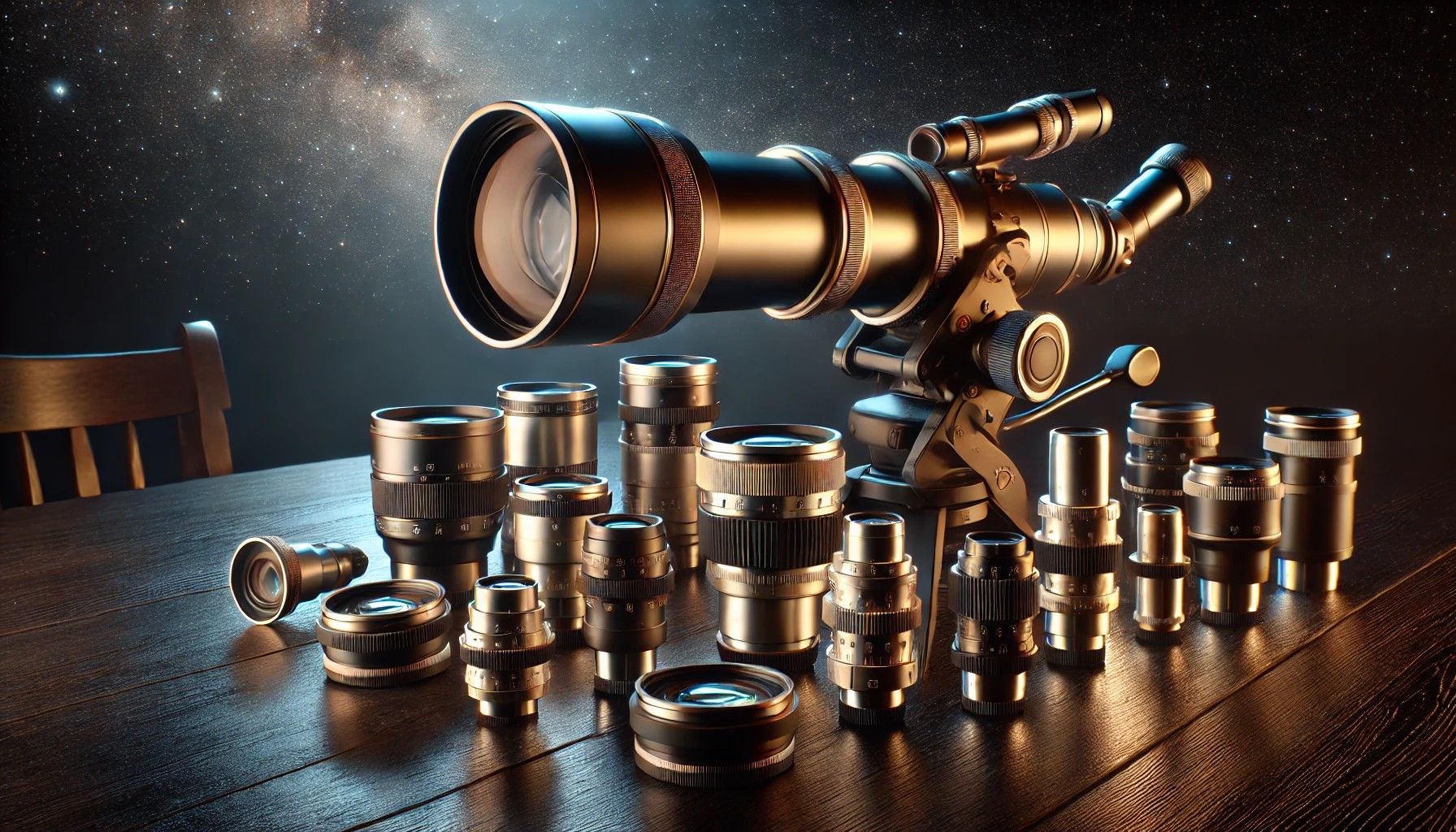Choosing the right eyepiece for a telescope determines how much detail you can see and how comfortable your viewing experience will be. The right choice depends on focal length, magnification, field of view, and eye relief. Understanding these factors ensures a telescope performs at its best.
1. Understanding Eyepiece Focal Length
Eyepiece focal length, measured in millimeters (mm), affects magnification. A lower number increases magnification, while a higher number provides a wider view. The formula for magnification is:
Magnification = Telescope Focal Length ÷ Eyepiece Focal Length
For example, a 1000mm focal length telescope with a 10mm eyepiece provides 100x magnification.
How to Choose Based on Focal Length
- Low power (25mm-40mm) – Wide views, ideal for star clusters and nebulae.
- Medium power (10mm-20mm) – Balanced detail and brightness, suited for galaxies and the Moon.
- High power (3mm-9mm) – Best for planetary details and double stars, though seeing conditions must be stable.
2. Field of View: Apparent vs. True
Field of view (FOV) determines how much sky is visible through the eyepiece. Two key measurements matter:
- Apparent Field of View (AFOV) – Measured in degrees, this describes the angular width of the eyepiece’s view.
- True Field of View (TFOV) – The actual sky portion visible through the telescope, calculated as: TFOV = AFOV ÷ Magnification
A wider AFOV provides immersive views, reducing the need to reposition the telescope frequently.
3. Eye Relief: Comfort for Extended Viewing
Eye relief is the distance from the eyepiece lens to the point where the full image forms. Longer eye relief (15mm or more) is beneficial for those who wear glasses. Shorter eye relief can cause discomfort and restrict the field of view.
4. Eyepiece Types and Their Uses
Eyepiece design affects image quality, contrast, and comfort.
- Plössl – A cost-effective choice with good sharpness and a typical AFOV of 50°.
- Orthoscopic – High contrast and sharpness, preferred for planetary viewing.
- Wide-Angle (68°-82° AFOV) – Immersive views, great for deep-sky objects.
- Zoom Eyepieces – Adjustable focal lengths, useful for variable magnifications.
- Long Eye Relief (LER) Eyepieces – Designed for eyeglass wearers, maintaining a wide view.
5. Matching Eyepieces to Telescope Type
Each telescope type benefits from specific eyepiece choices:
- Refractors – Perform well with all eyepieces, but wide-angle options enhance deep-sky viewing.
- Dobsonians/Newtonians – Benefit from long focal length and wide AFOV eyepieces to track objects longer.
- Maksutov-Cassegrain & Schmidt-Cassegrain – Work best with high-contrast eyepieces for planetary details.
6. Choosing the Right Barrel Size
Eyepiece barrels come in three standard sizes:
- 1.25-inch – Most common, balancing cost and performance.
- 2-inch – Offers wider views but requires a compatible focuser.
- 0.965-inch – Found in older or budget telescopes, often limiting performance.
7. The Importance of Exit Pupil
Exit pupil is the diameter of light exiting the eyepiece and should match the observer’s eye. Calculated as:
Exit Pupil = Eyepiece Focal Length ÷ Telescope Focal Ratio
- Large exit pupil (5-7mm) – Best for faint deep-sky objects.
- Medium exit pupil (2-4mm) – Ideal for balanced viewing.
- Small exit pupil (1mm or less) – Necessary for high-power planetary views.
8. Barlow Lenses: Expanding Eyepiece Options
A Barlow lens multiplies an eyepiece’s magnification by 2x or 3x, effectively doubling an eyepiece collection without buying additional ones. For instance, a 20mm eyepiece with a 2x Barlow functions as a 10mm.
9. Avoiding Common Mistakes
- Over-magnification – Exceeding the telescope’s limit leads to dim, blurry images. A practical maximum magnification is 2x the telescope aperture in millimeters.
- Neglecting FOV – Narrow FOV eyepieces require frequent adjustments.
- Ignoring Eye Relief – Short relief can make viewing uncomfortable, especially for eyeglass wearers.
10. Building a Balanced Eyepiece Collection
A well-rounded set includes:
- One low-power (25mm-40mm) – Wide-field views.
- One medium-power (10mm-20mm) – General-purpose observation.
- One high-power (3mm-9mm) – Detailed lunar and planetary viewing.
- A Barlow lens – To double available magnifications.
Final Thoughts
Selecting the right eyepiece depends on magnification needs, comfort, and viewing preferences. A balanced set tailored to a telescope’s focal length and intended use ensures the best results for any observer.
